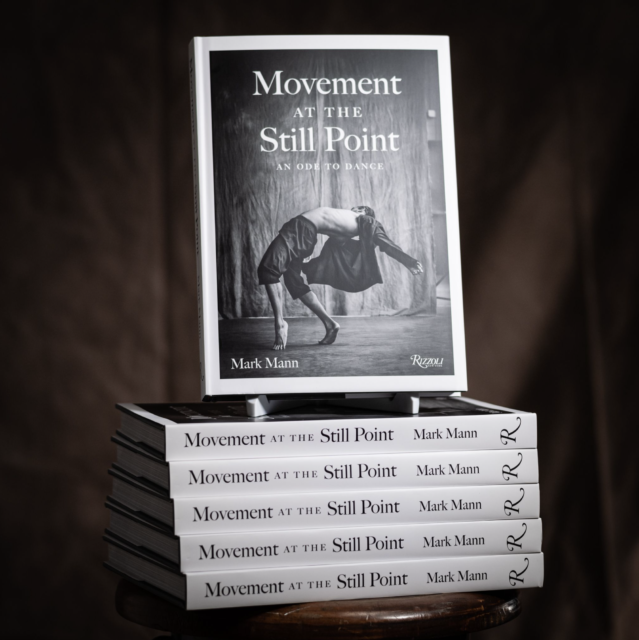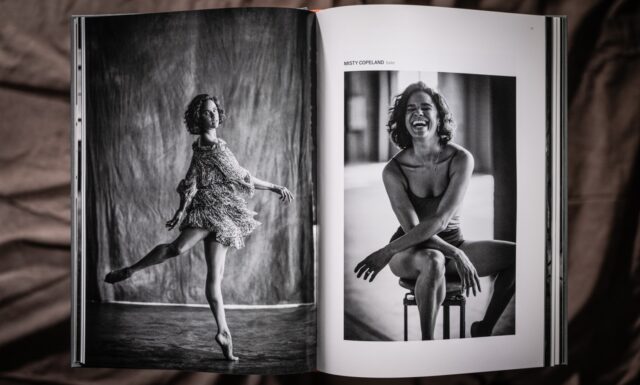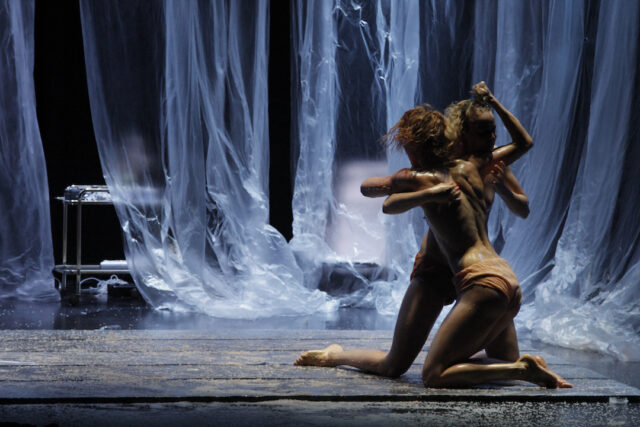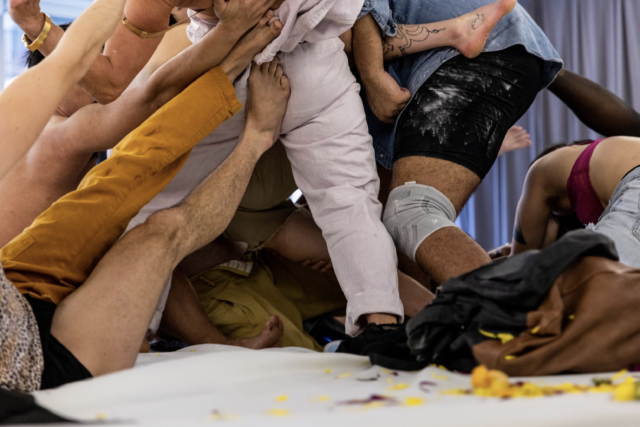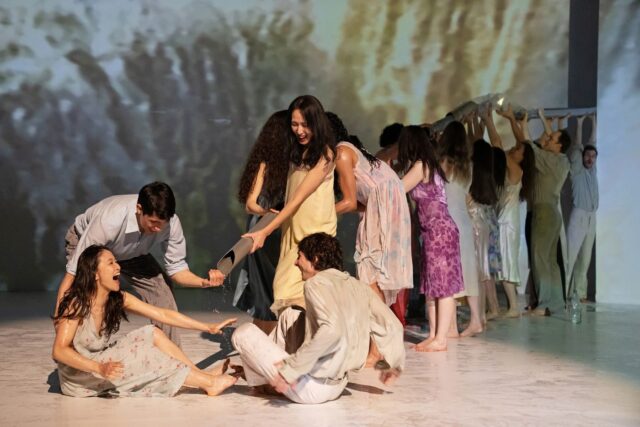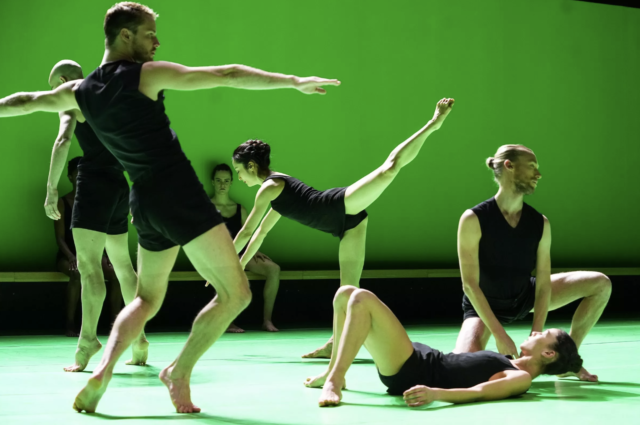
Humanity gets caught up in the maelstrom in Faye Driscoll’s Weathering (photo by Maria Baranova / courtesy New York Live Arts)
WEATHERING
New York Live Arts
219 West Nineteenth St. between Seventh & Eighth Aves.
April 5-8, 12-15, $32-$50, 7:30
212-924-0077
newyorklivearts.org
www.fayedriscoll.com
Faye Driscoll’s latest work, Weathering, is, well, everything.
The seventy-minute piece, continuing at New York Live Arts through April 15, takes place on a squishy white movable platform raft designed by Jake Margolin and Nick Vaughan. The audience sits on all four sides of the object. One by one, ten performers — James Barrett, Kara Brody, Miguel Alejandro Castillo, Amy Gernux, Shayla-Vie Jenkins, Jennifer Nugent, Cory Seals, Eliza Tappan, Carlo Antonio Villanueva, and Jo Warren, in Karen Boyer’s costumes of everyday dress, some with backpacks, bags, and other accoutrements — step on and off the platform, eventually all standing in place and freezing, becoming what Driscoll calls a flesh sculpture.
Stage managers Emily Vizina and Ryan Gamblin, in all black, go to opposite corners and gently push the platform so it spins around, extremely slowly at first. The dancers barely move a muscle, but as the platform rotates, you can start to tell that the performers have shifted ever so slightly, lowering a knee, reaching out a hand, turning a foot, almost imperceptibly; the effect is like you are watching a living, creeping flipbook. Soon they begin touching, the connections electrifying, as if the contact is life affirming, which is especially potent as we emerge from Covid restrictions that kept us physically apart from one another. As the bodies interweave, they close gaps, filling spaces of loss and absence.
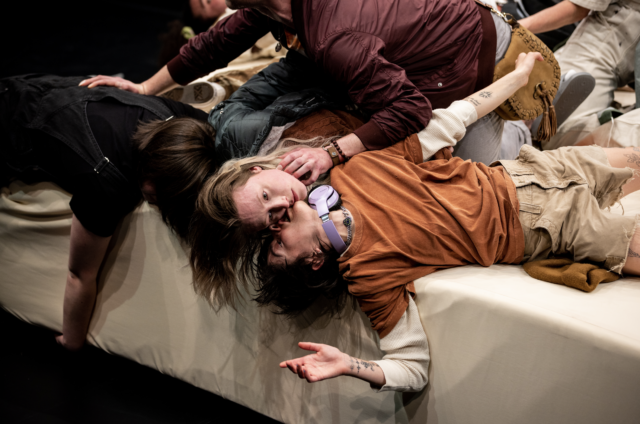
Performers encounter all five senses while spinning around the New York Live Arts stage (photo by Maria Baranova / courtesy New York Live Arts)
Driscoll incorporates all five senses as she and the stage managers occasionally spray the performers (and the audience) with citrus-smelling water and some of the dancers let out small groans and grunts as they put their mouths on an arm, leg, or neck that approaches them, somewhere in between the hunger for sex and the hunger of zombies seeking sustenance.
As the score builds — the sound and music direction is by Sophia Brous, with live sound and sound design by Ryan Gamblin and composition, field recordings, and sound design by Guillaume Malaret — the raft is spun around faster and faster. Personal items fall haphazardly to the ground: keys, a wallet, cellphones. Clothes start coming off, revealing more of who these people are and challenging what we might have previously thought about them while harkening back to our primeval existence, equating the beginning and the end. Chaos ensues, as the audience tries to capture as much of the action as it possibly can, not wanting to miss a single thing, as if every little movement, every sound, every change could upset the balance of this mini-universe.
Driscoll is telling us to pay attention, letting us know that humanity is failing and we are destroying the planet. The raft, evoking Earth and its orbit, sometimes slides slightly out of control, nearly hitting the people in the first row.
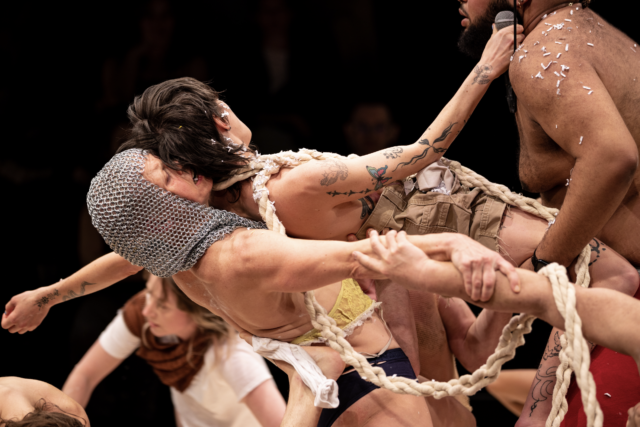
Faye Driscoll’s Weathering continues at NYLA through April 15 (photo by Maria Baranova / courtesy New York Live Arts)
The faster the raft goes, the more the audience is overcome by an intoxicating joy mixed with impending doom; it is absolutely exhilarating to follow each of the performers’ journeys, ten individuals striving to survive on their own and as a group, just as we in the audience are.
The show is accompanied by the companion reader Durations of Short Detail, with short pieces by dramaturg Dages Juvelier Keates (“We Are So Close”), dancer and choreographer Jesse Zaritt (“To Hold and Be Held”), and Driscoll, whose poem “Chariots of Flesh” relates, “We’ve been trembling in the trench for / Days? / Weeks? / Years? / Lifetimes? / Despite thick fog / I am overcome / By the smell of your clean shaven skin / Face, eyes, gaze, nose, mouth, fear / I try to pound you out but you latch onto my arm, / wrap your leg around me and reverse position / You try to pound me out but I latch onto your arm, / wrap my leg around you and reverse position / We are desperate to know the outcome / Desperate to know the outcome / Desperate to know the outcome. . . .”
As she has in such previous pieces as the Thank You for Coming trilogy, You’re Me, and There is so much mad in me, Driscoll investigates the intrinsic relationship between performer and audience, the imperative bond, but there is a lot more at stake in Weathering, nothing less than the future of the human race.
I don’t know that we can save the world through art, but with creators such as Driscoll, we can have a hell of a lot of terrifying fun trying.
